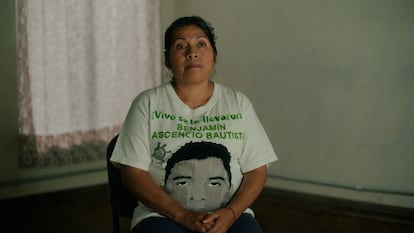They disappeared almost a decade ago and the whereabouts of the vast majority of them are still unknown. They were 43 boys, children of peasants, students of the Ayotzinapa teacher training school, who were arrested and murdered by the security forces, in collusion with criminal groups, one night at the end of September 2014, leaving behind a trail of crimes that overlap with the original and add up to hundreds of unknowns that remain unsolved. It is the most traumatic case in recent Mexican history and possibly the one that generates the most doubts about it. Perhaps that is why the need to reconstruct it, to continue pursuing the right questions, persists. The team from the production company PAR media has dedicated itself to this task, neither simple nor new, for two years, which this month, coinciding with the tenth anniversary of the event, presents The Ayotzinapa 43: a state crimea five-episode documentary miniseries that will be available weekly on HBO beginning September 5.
“What we sought, with the number of voices that agreed to participate in the documentary from all fronts — the Government, survivors, victims, journalists linked to the investigation — is to try to show the most open and transversal panorama possible so that the viewer can draw the most informed conclusion so far,” explains Esteban Vidal, executive producer of the series. Within this amalgam of testimonies, the most difficult to obtain and those that required the most time and work, adds José Ortiz, director of the project, were those of “the officials who carried out the investigation at that time.” Among them, those of Miguel Ángel Osorio Chong, Secretary of the Interior under Enrique Peña Nieto, and that of Tomás Zerón, then head of the Prosecutor’s Investigation Agency, and today a fugitive from justice in Israel, accused of torture and forced disappearance, among other charges.
One of the keys to obtaining their contributions, along with that of Yazareth Abarca, daughter of the then mayor of Iguala, José Luis Abarca — convicted and later acquitted for the disappearance of the 43 young people — who had not spoken to the press until now, was to assure them that they could “speak freely and tell whatever they wanted.” Of course, Ortiz says, they were also warned that “they would be asked about everything.” Thus, in the documentary you can see the controversial images in which Zerón appears interrogating a detainee, followed by the statements of the former official himself, who continues to claim that, although he overstepped his boundaries, he never went beyond a mere threat.
Between one cut and another there is no voice in off or narrator “who can add an annotation or interpret” what the person has said, it is the images themselves that reinforce or deny, in each case, the testimony of each interviewee. A “fairly large guarantee,” says Ortiz, that no conversation is manipulated: “The testimonies come out clean.” There is, however, no equidistance: the so-called “historical truth” is confronted with the newspaper archives, with the visual and oral record of the real events and with the rest of the testimonies, among which are those of the independent experts who formed part of the GIEI, the investigation team promoted by the Inter-American Commission on Human Rights that worked during the first year and a half after the events and that was recovered by López Obrador at the beginning of his mandate.
To guide the entire structure, the creators have created a timeline that helps the viewer understand the order of events, despite the temporal or spatial leaps of a case that continues to add new episodes almost every week. Just a few days ago, the bulk of the families of the 43 have left the dialogue table with López Obrador, a bitter end to a six-year term that initially raised many expectations after the discovery of the remains of two of the missing, a milestone that pushed forward an investigation that has run aground again. “It is a case that will continue to live,” Vidal concedes, “and this new information that is coming out forces this type of documentary to exist, because it allows us to understand why what is happening now is happening.”
He Ayotzinapa case The series showed the world the worst version of the Mexican State in a country besieged by violence. But it is an episode that resonates throughout the continent. “Although it is fundamentally Mexican, the story, the search for the parents, the disappearances, unfortunately, are issues that affect the entire region,” says Vidal. It is the entire region that this series addresses, to continue asking, until we get an answer, what happened that September night, why it happened and, above all, 10 years later, where are they?

Sign up for the free EL PAÍS Mexico newsletter and to WhatsApp channel and receive all the latest news on current events in this country.
#Ayotzinapa #reconstruction #decade #impunity